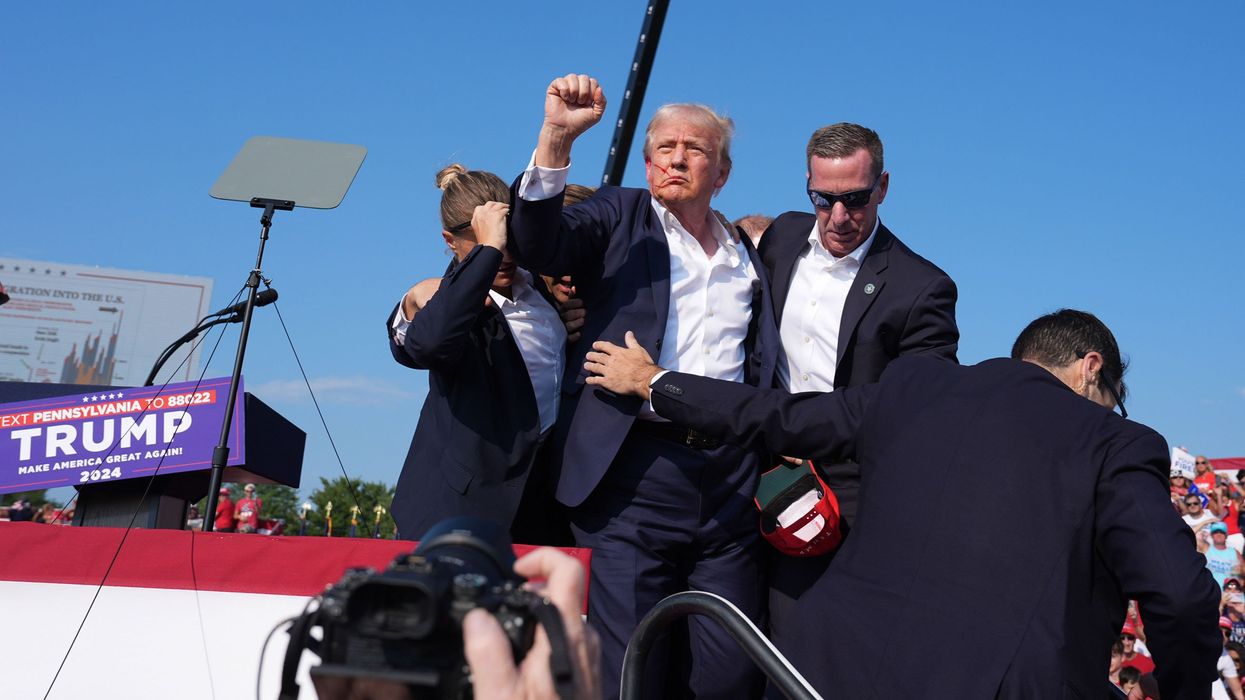Tomson is research manager for the Center for an Informed Public and the University of Washington. Haughey and Prochaska are graduate research assistants and the Center for an Informed Public.
In the immediate hours after the assassination attempt on former president Donald Trump on July 13, 2024, social media users posted the same videos, images and eyewitness accounts but used them as evidence for different rumors or theories that aligned with their political preferences.
Among the deluge of rumors, one TikTok creator narrated the instantly iconic photo of Trump raising his fist, ear bloodied as he emerged from the Secret Service scrum. “People are wondering if this photo is staged?” His answer: “Yes.”
People across the political spectrum, including President Joe Biden, questioned why the Secret Service had failed to prevent the attack. But then some people took this critique further. An influencer on the social media platform X posted an aerial photo and asked how an armed assailant could make it to an unsecured rooftop, concluding, “This reeks of an inside job.”
As researchers who study misinformation at the University of Washington’s Center for an Informed Public, we have seen groups of people coming together during previous crises to make sense of what is going on by providing evidence and interpreting it through different political or cultural lenses called frames. This is part of a dynamic process scholars call collective sensemaking.
Spreading rumors is a part of this process and a natural human response to crisis events. Rumors, regardless of their accuracy, help people assign meaning and explain an uncertain or scary unfolding reality. Politics and identity help determine which frames people use to interpret and characterize evidence in a crisis. Some political operatives and activists may try to influence these frames to score points toward their goals.
In the aftermath of the assassination attempt, our rapid response research team observed rumors unfolding across social media platforms. We saw three politically coded frames emerge across the spectrum:
- claiming the event was staged
- criticizing the Secret Service often by blaming Diversity Equity and Inclusion initiatives
- suggesting the shooting was an inside job
‘It was staged’
On the anti-Trump extreme, a rumor quickly gained traction claiming the shooting was staged for Trump’s political gain, though this has slowed as more evidence emerged about the shooter. One creator questioned if the audience were crisis actors because they did not disperse quickly enough after the shooting. Others pointed to Trump’s history with World Wrestling Entertainment and reality television, suggesting he had cut himself for dramatic effect like pro wrestlers. Entertainment professionals weighed in, saying Trump had used fake blood packets found in Hollywood studios.
The staged rumor resonated with a conspiratorial frame we’ve seen people use to process crisis events, such as accusations of a false flag event or crisis actors being used to facilitate a political victory.
Secret Service failings
On social and mainstream media, we saw questioning across the political spectrum of how the Secret Service failed to protect a presidential candidate. Many compared videos of the Secret Service’s swift reaction to the 1981 assassination attempt on President Ronald Reagan, suggesting their reaction with Trump was slower.
However, some politicized this frame further, blaming DEI for the Secret Service’s failure. The claim is that efforts to increase the number of women in the Secret Service led to unqualified agents working on Trump’s security detail.
Blaming DEI is a common and increasingly used trope on social media, recently seen in rumors following the Baltimore bridge collapse and the Boeing whistleblower crisis. Pro-Trump creators shared images critical of female Secret Service agents juxtaposed against celebrated images of male service members. This is a framing we expect to continue to see.
Adjacent to this critique framing, a rumor took hold among pro-Trump communities that the Secret Service had rejected Trump’s additional security requests, which the GOP had been investigating — a claim the Secret Service has denied. This narrative was further fueled by recent proposed legislation calling for the removal of Trump’s Secret Service protection if he were sentenced to prison following a conviction for a felony.
‘It was an inside job’
Highlighting many of the same critiques and questions of how the shooter could get to an unsecured rooftop, other influencers suggested the shooting must have been an inside job. In retweeting a popular pro-Trump influencer, Elon Musk speculated that the mistake was either “incompetence” or “deliberate.” A popular post on X – formerly Twitter – tried to make sense of how a 20-year-old could outsmart the Secret Service and concluded by insinuating the failure was potentially intentional.
These inside job speculations are similar to the rumor that the shooting was staged – though they emerged slightly later – and they align with claims of false flag operations in previous crisis events.
Rumor-spreading is human nature
As the crisis recedes in time, rumors are likely to persist and people are likely to adjust their frames as new evidence emerges – all part of the collective sensemaking process. Some frames we’ve identified in this event are likely to also evolve, like political critiques of the Secret Service. Some are likely to dissipate, like the rumor that the shooting was staged.
This is a natural social process that everyone participates in as we apply our political and social values to rapidly shifting information environments in order to make sense of our realities. When there are intense emotions and lots of ambiguity, most people make mistakes as they try to find out what’s going on.
Getting caught up in conspiracy theorizing after a tragedy – whether it’s for political, social or even entertainment reasons – is a common human response. What’s important to remember is that in the process of collective sensemaking, people with agendas other than determining and communicating accurate information may engage in framing that suits their interests and objectives. These can include foreign adversaries, political operatives, social media influencers and scammers. Some might continue to share false rumors or spin salacious narratives for gain.
It’s important not to scold each other for sharing rumors, but rather help each other understand the social dynamics and contexts of how and why rumors emerge. Recognizing how people’s political identities are intentionally exploited – and even just incidentally make people susceptible – to spread false rumors may help them become more resilient to these forces.![]()
This article is republished from The Conversation under a Creative Commons license. Read the original article.


















A deep look at how "All in the Family" remains a striking mirror of American politics, class tensions, and cultural manipulation—proving its relevance decades later.
All in This American Family
There are a few shows that have aged as eerily well as All in the Family.
It’s not just that it’s still funny and has the feel not of a sit-com, but of unpretentious, working-class theatre. It’s that, decades later, it remains one of the clearest windows into the American psyche. Archie Bunker’s living room has been, as it were, a small stage on which the country has been working through the same contradictions, anxieties, and unresolved traumas that still shape our politics today. The manipulation of the working class, the pitting of neighbor against neighbor, the scapegoating of the vulnerable, the quiet cruelties baked into everyday life—all of it is still here with us. We like to reassure ourselves that we’ve progressed since the early 1970s, but watching the show now forces an unsettling recognition: The structural forces that shaped Archie’s world have barely budged. The same tactics of distraction and division deployed by elites back then are still deployed now, except more efficiently, more sleekly.
Archie himself is the perfect vessel for this continuity. He is bigoted, blustery, reactive, but he is also wounded, anxious, and constantly misled by forces above and beyond him. Norman Lear created Archie not as a monster to be hated (Lear’s genius was to make Archie lovable despite his loathsome stands), but as a man trapped by the political economy of his era: A union worker who feels his country slipping away, yet cannot see the hands that are actually moving it. His anger leaks sideways, onto immigrants, women, “hippies,” and anyone with less power than he has. The real villains—the wealthy, the connected, the manufacturers of grievance—remain safely and comfortably offscreen. That’s part of the show’s key insight: It reveals how elites thrive by making sure working people turn their frustrations against each other rather than upward.
Edith, often dismissed as naive or scatterbrained, functions as the show’s quiet moral center. Her compassion exposes the emotional void in Archie’s worldview and, in doing so, highlights the costs of the divisions that powerful interests cultivate. Meanwhile, Mike the “Meathead” represents a generation trying to break free from those divisions but often trapped in its own loud self-righteousness. Their clashes are not just family arguments but collisions between competing visions of America’s future. And those visions, tellingly, have yet to resolve themselves.
The political context of the show only sharpens its relevance. Premiering in 1971, All in the Family emerged during the Nixon years, when the “Silent Majority” strategy was weaponizing racial resentment, cultural panic, and working-class anxiety to cement power. Archie was a fictional embodiment of the very demographic Nixon sought to mobilize and manipulate. The show exposed, often bluntly, how economic insecurity was being rerouted into cultural hostility. Watching the show today, it’s impossible to miss how closely that logic mirrors the present, from right-wing media ecosystems to politicians who openly rely on stoking grievances rather than addressing root causes.
What makes the show unsettling today is that its satire feels less like a relic and more like a mirror. The demagogic impulses it spotlighted have simply found new platforms. The working-class anger it dramatized has been harvested by political operatives who, like their 1970s predecessors, depend on division to maintain power. The very cultural debates that fueled Archie’s tirades — about immigration, gender roles, race, and national identity—are still being used as tools to distract from wealth concentration and political manipulation.
If anything, the divisions are sharper now because the mechanisms of manipulation are more sophisticated, for much has been learned by The Machine. The same emotional raw material Lear mined for comedy is now algorithmically optimized for outrage. The same social fractures that played out around Archie’s kitchen table now play out on a scale he couldn’t have imagined. But the underlying dynamics haven’t changed at all.
That is why All in the Family feels so contemporary. The country Lear dissected never healed or meaningfully evolved: It simply changed wardrobe. The tensions, prejudices, and insecurities remain, not because individuals failed to grow but because the economic and political forces that thrive on division have only become more entrenched. Until we confront the political economy that kept Archie and Michael locked in an endless loop of circular bickering, the show will remain painfully relevant for another fifty years.
Ahmed Bouzid is the co-founder of The True Representation Movement.